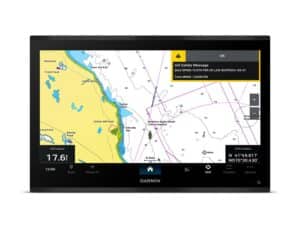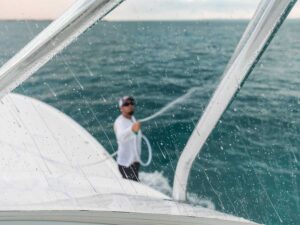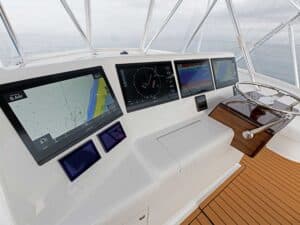Marine electronics are so operator-friendly that they seem to think like us and do what we expect them to do. We can use them easily without really having to think about what makes them work. That’s what we call intuitive design.
Just as you start to get comfortable and begin to rely on your electronic eyes and ears, however, one of your displays blacks out, or the radar goes offline, or the sonar can’t find the bottom with both transducers. Now the little black box holds a mystery, and the secret is either inside the box or encoded in the spaghetti pile of wires that make it run. Diagnosing the problem can be tricky, but the sleuths who troubleshoot electronics systems for a living use several cool tricks that can help you unravel the mystery.
Handy Manual
Yep, most electronics glitches occur after the user has inadvertently screwed something up, so reading the manual can reveal the solution to your problem and also prevent your making the mistake in the first place. Though most glitches usually happen soon after the installation of a suite, keeping the manual handy on board is likely to be useful for boning up on new features — or just settling a bet on the best way to use your device.
Sonar Solution
Most boats have multiple sonars and transducers. If you have both transducers set to transmit at the same frequency, they will interfere with each other, causing diagonal lines across the screen or other interference that reduces the clarity of the image. It happens more often than you’d think.
Dark Screen
The worst happens. Your display goes dark. First, get as much light on it as possible and look for a ghostlike image to determine if the unit is really off or if you just have a failed backlight element. Problems with voltage variations or excessively high temperatures behind or around your displays can cause your backlight to fail. If the backlight has burned out, get the unit back to the manufacturer for repair.
No Connection
What do you do if your screen is obviously powered up and you’re getting an image when using other units, but your sonar, for example, isn’t coming up on the display? Try unplugging the connectors on the display and on the black box. If you’ve got a spare cable, try that one. Or if you have a backup unit, switch the cables. While today’s cables are nearly watertight, corrosion of the pins or sockets can still occur, and removing them and re-plugging can resolve the issue.
No Backbone
Some devices transmit data directly to the display, like sonar. Some devices, like stereo equipment or GPS antennas, go through the NMEA Network, often nicknamed “the backbone.” It’s a series of joined T-shaped connectors that resembles a spine with stubby ribs. In the early days of NMEA 2000 protocol, the backbone T’s failed from time to time. That doesn’t happen as often these days, but if it does, try moving the device to another T. If it gets the job done, change the old T.
Locked Up
Sometimes a display will lock up with a frozen screen, and you can’t even turn it off with the power button. Pull the power cord on the back. If the device feels hot to the touch, let it cool down; then reconnect and power up. Rebooting often solves the problem.
Firmware Update
Thanks to the updatable firmware of most modern navigation devices, you can also reset the system with a firmware update. The glitch is often caused by a problem discovered in the firmware, and is then corrected in the update. Your manufacturer’s online support page will have firmware downloads that you can transfer to an SD card or a USB drive, as the unit requires.
Hot and Bothered
According to the National Marine Electronics Association (NMEA), the ideal operating environment for electronics equipment is no more than 85 degrees. Add 10 degrees to that, and you can expect to reduce the life of your equipment by 40 percent. That’s a pretty sobering statistic for those of us who fish during the heat of the summer. Most yacht builders now design electronics cabinets that ventilate naturally or use fans. However, overheating is still a major cause of failure in electronics suites.
Power In, Power Out
If you’ve tried all of these steps and you’re still facing a blank screen, chances are you have wiring issues. For most boaters, finding that wiring problem can be more confusing than reading Greek. It helps to look at your 12-volt power like plumbing. One line brings your device the juice it needs, and the other takes it away. Your device skims the power from the circuit, like sipping from a water fountain.
Trim and Heat-Shrink Seal
If the power cable fails to provide power to the unit, the problem is obviously going to be either in the cable — which is rare — or the cable connection. Wire terminal ends are the most frequent culprit when something goes wrong with your 12-volt connections, especially in marine environments. Trim off the old ones — both black (ground, or negative) and red (positive) — by removing at least an inch or so of wire. Strip the ends and refit using brand-new heat-shrink connectors. Heat the terminal connector until it shrinks tight, creating a new watertight seal. Sadly, too few boatbuilders leave enough wire at the terminal ends to trim and refit them, creating trouble for the repair technician. Just a 6-inch loop at the terminal would be so much nicer for the long-term owner.
No power yet? Go deeper. Now you know that the ground wire, the switch or the power wire is suspect.
Shorts
A tougher problem is a short between two wires. As boats age, their wiring harnesses chafe, and insulation can be worn away, causing wire-to-wire contact.
The first sign that this is happening is if two devices begin to malfunction at the same time. Disconnect the two power cables from the power source, and using your ohmmeter, connect the probes to each wire. If you get a reading of anything but zero, you’ll need to replace those two wires — that’s usually more effective than trying to find the scars and repair them.
Some shorts are “shorts to ground,” which occur when the positive wire comes in contact with the ground wire. When this happens, it robs the current from the device, discharges your battery, and often causes a fire.
While marine electronics are user-friendly and manufacturers continue to develop better and better wiring practices, boats still operate in a hostile environment. Experienced captains know that trouble is a function of the harsh world in which we fish. A little do-it-yourself ingenuity is essential for any enthusiastic billfisherman.







